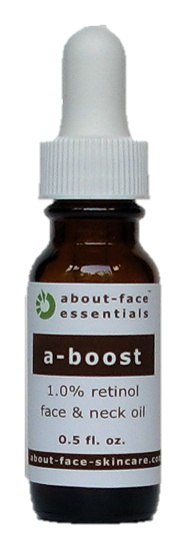
A-Boost
Highlights
Skim through
| Ingredient name | what-it-does | irr., com. | ID-Rating |
|---|---|---|---|
| Caprylic/Capric Triglyceride | emollient | ||
| Rosa Mosqueta (Rose Hip) Seed Oil | antioxidant, emollient | goodie | |
| Phospholipids | skin-identical ingredient, emollient | goodie | |
| Retinol | cell-communicating ingredient | superstar | |
| Dipalmitoyl Hydroxyproline | |||
| Teprenone | cell-communicating ingredient | goodie | |
| Tocopherol | antioxidant | 0-3, 0-3 | goodie |
| Sambucus Nigra Fruit Extract |
about-face essentials A-BoostIngredients explained
A super common emollient that makes your skin feel nice and smooth. It comes from coconut oil and glycerin, it’s light-textured, clear, odorless and non-greasy. It’s a nice ingredient that just feels good on the skin, is super well tolerated by every skin type and easy to formulate with. No wonder it’s popular.
The oil coming from the seeds of the wild rose bush most common in the southern Andes in Chile (btw, Rosa Rubiginosa, Rosa Eglanteria and Rosa Mosqueta all refer to the same oil, however, the more commonly used Rosa Canina is a bit different). Similar to many other great plant oils, it is a nice nourishing and moisturizing oil loaded with fatty acids (linoleic acid - 44%, linolenic acid - 34% and oleic acid - 14%).
What makes rosehip oil a special snowflake among all the plant oils out there is that it also contains the miracle active, trans-retinoic acid, aka tretinoin. It is the main bioactive component of the oil and has all kinds of magic abilities including restoring and regenerating tissues (the oil is great for scars and burns), decreasing wrinkles, helping acne and even normalizing pore size.
A type of lipid that's the major (about 75%) component of all cell membranes. As for skincare, it works as an emollient and skin-identical ingredient.
It has a water-loving head with two water-hating tails and this structure gives the molecule emulsifying properties. It is also often used to create liposomes, small spheres surrounded by phospholipid bi-layer designed to carry some active ingredient and help its absorption.
- Retinol (pure Vitamin A) is probably the most proven anti-aging ingredient available OTC
- It has to be converted in the skin to retinoic acid to work its magic
- Once converted, it has the same effect as all-trans-retinoic acid, aka tretinoin
- A generally accepted ballpark number is that retinol is 10-to-20 times less potent than retinoic acid
- It makes skin less wrinkled, smoother, firmer and tighter
- It might also be helpful for acne prone skin as it normalizes keratinization and makes the pores produce less sebum
- Possible side effects and irritation are also much less than with retinoic acid
- Do not use whilst pregnant

An anti-aging active ingredient that's claimed by its manufacturer to fight "all signs of aging" from dehydration, damaged skin barrier, and redness to age spots, wrinkles, and even pores. It works by telomere (the protecting end part of the chromosomes that get shorter during chromosome replication) stabilization and DNA maintenance and is claimed to be able to expand cell lifespan by a third. It might also improve the tissue quality by optimizing cell communication and cell metabolism.
The manufacturer did a simple blind study of 24 participants to back up these rather extraordinary claims. They found that 3% Renovage cream used for 6 months increased skin moisturization by 30-58% for all panelists, improved barrier integrity by 19-46% for 75% of panelists and fade UVsunspotss by 42 to 56% for all panelists.
- Primary fat-soluble antioxidant in our skin
- Significant photoprotection against UVB rays
- Vit C + Vit E work in synergy and provide great photoprotection
- Has emollient properties
- Easy to formulate, stable and relatively inexpensive

You may also want to take a look at...
| what‑it‑does | emollient |
| what‑it‑does | antioxidant | emollient |
| what‑it‑does | skin-identical ingredient | emollient |
| what‑it‑does | cell-communicating ingredient |
| what‑it‑does | cell-communicating ingredient |
| what‑it‑does | antioxidant |
| irritancy, com. | 0-3, 0-3 |





